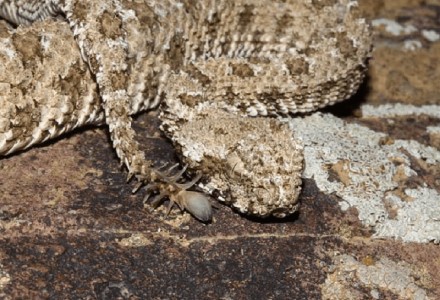
Spider Tailed Viper Facts
- First of all, the descriptive term Spider Tailed Viper serves as the common name for a truly astonishing species of reptile. This fascinating creature also possesses one of the most remarkable and resourceful evolutionary adaptations ever seen in the entire animal kingdom.
- That’s because the tail of this truly remarkable snake grows tipped with an astounding appendage. In point of fact, this physical feature bears a remarkable resemblance to a spider. The aptly named reptile also uses this appendage as a lure, to attract potential prey to its fate.
- The extremely cunning and resourceful species also employs great skill in the use of this gift Nature bestowed upon it. That’s because the fabulous reptile doesn’t just sit idle, waiting for its meal. It actually moves this evolutionary advantage in a manner resembling the motions of an arachnid.
- Finally, the unique variety of snake also remains a true master of disguise in its native habitat. That holds true because, while waiting for its prey, the snake blends extremely well into the surrounding terrain. The color patterns provide it with a perfect natural camouflage.
Related Articles
Tiger Rattlesnake Eastern Diamondback Rattlesnake Spiny Bush Viper
Photographer: Omid Mozaffari
Public Domain Image
Spider Tailed Viper Physical Description
The astonishing Spider Tailed Viper, despite its otherwise unique characteristics, remains an average-sized snake. In this manner, at least, it resembles other related species. That’s because adults typically average between 16-28 in (40 – 70 cm) in length.
In addition, the trait of sexual dimorphism also appears to be present in this species. In its case, this means that females average slightly greater in length. However, the somewhat smaller males often attain a somewhat greater girth than their female counterparts.
In addition, the head of this remarkable reptile grows rather broad and flat. Furthermore, it typically possesses a comparatively short, rounded snout. Additionally, coloring varies between individuals. But browns and grays predominate, to assist in blending in with the environment.
Yet, the most distinctive feature undoubtedly remains the one from which its common name derived. That is the spider-shaped growth on the end of its tail, used to attract its prey. In this, it remains unique among known varieties on snakes, in any part of the world.
- Kingdom: Animalia
- Phylum: Chordata
- Class: Reptilia
- Order: Squamata
- Family: Viperidae
- Genus: Pseudocerastes
- Species: P. urarachnoides
Photographer: Omid Mozaffari
Public Domain Image
Spider Tailed Viper Distribution, Habitat, and Ecology
Perhaps most notably, the incredible Spider Tailed Viper evolved as endemic to one region only. Furthermore, it ranks as a somewhat desolate and isolated part of the world. That region consists of the the rather rugged and remote mountain regions of western Iran, in Asia.
In addition, within its native habitat, the species primarily spends its time in rock crevices. Only if disturbed will it venture beyond this protected area. There, its natural camouflage permits this ambush predator to wait for its prey. This learned trait serves it well in its native habitat.
Also, this remarkable snake feeds on a variety of small mammals, like the majority of related creatures. Furthermore, most of its natural prey are themselves predators of spiders. As a result of this fact, a significant majority of its prey consists of various types of birds.
Finally, although the Spider Tailed Viper kills its prey with venom, the relative potency of its venom has never been studied. It therefore remains unknown if it represents a danger to man. Thankfully, both for it and humans, it is rarely encountered by human beings.
Creatures Sharing Its Range
Indian Bullfrog Bharal Saiga Antelope
Check out our other articles on 7 Spectacular Geological Marvels of Europe, Giant Trevally, Christmas Island, Giant Huntsman Spider, Turbinicarpus alonsoi, Black Rain Frog

